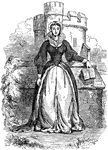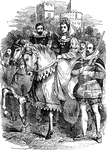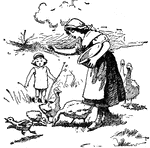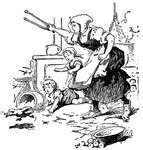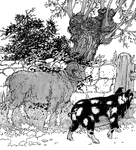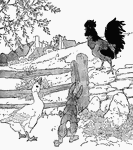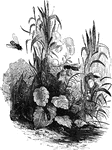
Honey Bee
"They are said to have originated in Greece, but have since spread all over the world; they live in…
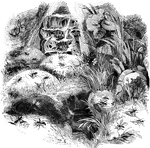
Ants and Their Structures
"This tribe, which includes the various kinds of Ants, is composed entirely of insects which live in…

Flea
"Aphaniptera includes the fleas, which, despite their minuteness, have made themselves a name in the…
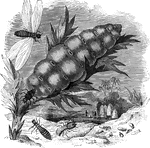
White Ants
"These animals, often called White Ants, live in vast communities, principally in the hotter…

Earwigs
"The Foficulina includes the Earwig, Forficula, which appears to live principally upon vegetable…
!["Like that animal [the mole] it is constantly engaged in burrowing in the earth; and to enable it to do this with facility iits anterior limbs are converted into a pair of flat, fossorial organs, which are turned outward in exactly the same manner as the hand of the mole. In its pasage through the earth it does great injury to the roots of plants, but it said to live quite as much upon animal as vegetable food." — Goodrich, 1859](https://etc.usf.edu/clipart/14900/14935/molecricket_14935_mth.gif)
Mole Cricket
"Like that animal [the mole] it is constantly engaged in burrowing in the earth; and to enable it to…

Drone Bee
"Bee is the common name given to a large family of hymenopterous or membranous-winged insects, of which…
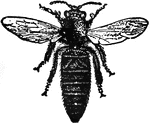
Queen Bee
"Bee is the common name given to a large family of hymenopterous or membranous-winged insects, of which…

Worker Bee
"Bee is the common name given to a large family of hymenopterous or membranous-winged insects, of which…

Royal Cells
"Bee is the common name given to a large family of hymenopterous or membranous-winged insects, of which…
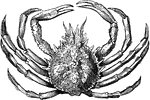
Spinous spider-crab
"In these the back is usually covered with spines and hairs. They generally live in deep water, and…
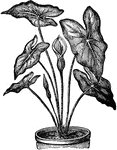
Caladium
"Caladium is a genus of endogenous plants, the typical one of the family caladieæ. They are cultivated…

Common sea-cucumber
"Sea-Cucumbers are of various forms, some of the species being found in nearly all seas. They…
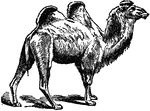
Camel
"Camel is a genus of ruminant quadrupeds, characterized by the absence of horns; a fissure in the upper…
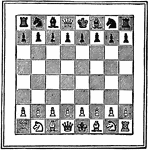
Chess Board
"Chess is the most purely intellectual of all games of skill, the origin of which has been much disputed,…

Chicory
Chicory is a flowering plant with blue flowers, originally from the Old World but now seen growing wild…
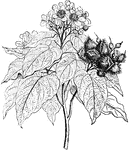
Arnotto
"Arnotto-extremely common in Jamaica and other parts of the West Indies, and has been introduced into…

Cemmeous Dragonet
"Dragonet is a genus of fishes remarkable for having the gill openings reduced to a small hole on each…
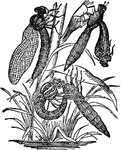
Dragonfly
"The Dragon Fly has a large, broad head, very freely attached to the thorax, and large, convex, prominent…
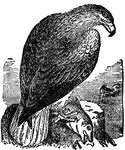
Erne
"The Erne is one of the 'bare-legged' eagles. The genus includes some seven species, represented apparently…

Tiger Head
"Felidæ or Felinæ is the cat tribe, a family of carnivorous quadrupeds, including the domestic…
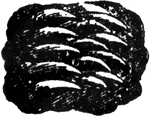
Partial Tiger Tongue
"Felidæ or Felinæ is the cat tribe, a family of carnivorous quadrupeds, including the domestic…
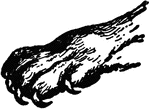
Tiger Paw
"Felidæ or Felinæ is the cat tribe, a family of carnivorous quadrupeds, including the domestic…
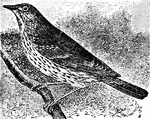
Song Thrush
"Thrush, in ornithology, is the name for any of the Turdidæ. They are universally distributed,…

Turnstone
"Turnstone is a small genus of birds of the plover family, intermediate between the true plovers and…
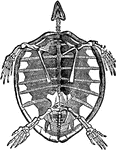
Skeleton of Turtle
"Turtle is, in zoology, the popular name for any species of the Cheloniidæ. They may be distinguished…
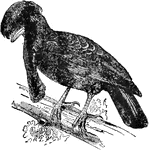
Umbrellabird
"The Umbrella Bird is a native of Peru. It is about the size of a crow, with deep black plumage; the…

Viper's Bugloss
"Viper's Bugloss is a genus of plants. The species are large herbaceous plants or shrubs, rough with…
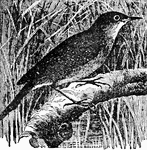
Reed Warbler
"Warbler is a popular name often applied to well-known singing birds of northern climes, whose notes…

Nest of Reed Warbler
"Warbler is a popular name often applied to well-known singing birds of northern climes, whose notes…
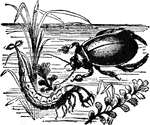
Water Beetle
"Water Beetles are beetles which live on or in the water. The Dytiscus, common in stagnant water, is…
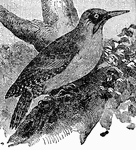
Green Woodpecker
"Woodpecker is the popular name of the old Linnæan genus Picus, now greatly divided. Woodpeckers…
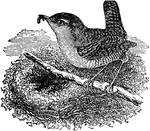
Wren
"Wren is a genus of birds, having a slender, slightly curved, and pointed bill; the wings very short…
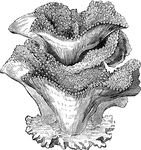
Tree-coral
"These animals are generally called Tree-corals, on account of the forms of the polypidons…
!["Hydrozoon is a name given to the great class of the sub-kingdom Cœlenterata, of which hydra is the type. They exhibit a definite histological structure, their tissues having a cellular organization. These tissues are two, an outer or ectoderm, and an inner or endoderm. In most the prey is seized by tentacles surrounding the mouth and furnished with offensive weapons called thread cells, The hydrozoa are all aquatic, and nearly all marine. Their distribution is world-wide. [Pictured] Hydra fusca, with a young bud at b, and a more advanced bud at c."—(Charles Leonard-Stuart, 1911)](https://etc.usf.edu/clipart/15400/15469/hydrozoon_15469_mth.gif)
Hydrozoon
"Hydrozoon is a name given to the great class of the sub-kingdom Cœlenterata, of which hydra is…
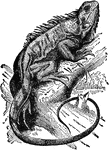
Iguana
"Iguana is a genus of saurian reptiles, natives of Brazil, Cayenne, the Bahamas, and neighboring localities…

Kinkajou
"Kinkajou is a genus of carnivorous mammals. They have prehensile tails, with which they hang on to…

Lizard
"Lizard is the popular name of numerous reptiles having usually two pairs of limbs and an elongated…
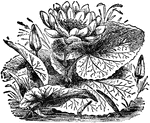
Egyptian Water Lily
"Lotus is a name given to various flowers, including several beautiful species of water lily, especially…

Mastodon
"Mastodon is an extinct genus of proboscideans, closely allied to the true elephants. The genus ranged…

City Hall of New York
"New York is a city in Southern New York; coextensive with New York, Kings, Queens, and Richmond counties,…
!["New York is a city in Southern New York; coextensive with New York, Kings, Queens, and Richmond counties, on New York Bay, the Hudson and East rivers, Long Island Sound and the Atlantic Ocean; the first city in the United States in population and commercial importance, and after London, the largest metropolitan center in the world. New York is noted for the number and height of its office buildings. In 1911 there were 50 such structures in occupancy, ranging from 14 to 50 stories in height, or from 179 to 700 feet above ground level, and 16 more were nearing completion. The tallest building was that of the Metropolitan Life Insurance Company, 700 and one quarter feet to top of lantern on its majestic tower. Other conspicuous ones [include the] Park Row, 382 [feet]."—(Charles Leonard-Stuart, 1911)](https://etc.usf.edu/clipart/15600/15666/nyparkrow_15666_mth.gif)
Park Row Building of New York
"New York is a city in Southern New York; coextensive with New York, Kings, Queens, and Richmond counties,…

Osprey
"The Osprey, the fish hawk, bald buzzard, or fishing eagle. A bird of prey, of almost world wide distribution…
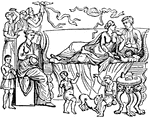
Accubatio
"The act of reclining at meals. The Greeks and Romans were accustomed, in later times, to recline at…

Demosthenes
"In the oratory of more thn two thousand years Demosthenes stands in the front rank, and will always…

Pompeiian House
"House construction consists mainly of concrete or brick, and sometimes of stone blocks, especially…

Marcus Aurelius Antoninus
"Marcus Aurelius Antoninus stands almost alone in the history of the world as a philosopher and philanthopist…

Byzantine court
"Constantine, the first Christian emperor, removed the capital of the world-empire from Rome to Byzantium,…
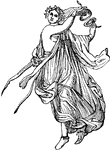
Calceus
"A shoe or boot, anything adapted to cover and preserve the feet in walking. The use of shoes was by…

Shoe-Billed Stork
The Shoe-Billed Stork is a bird related to the Storks that feeds on creatures that live in muddy water.
